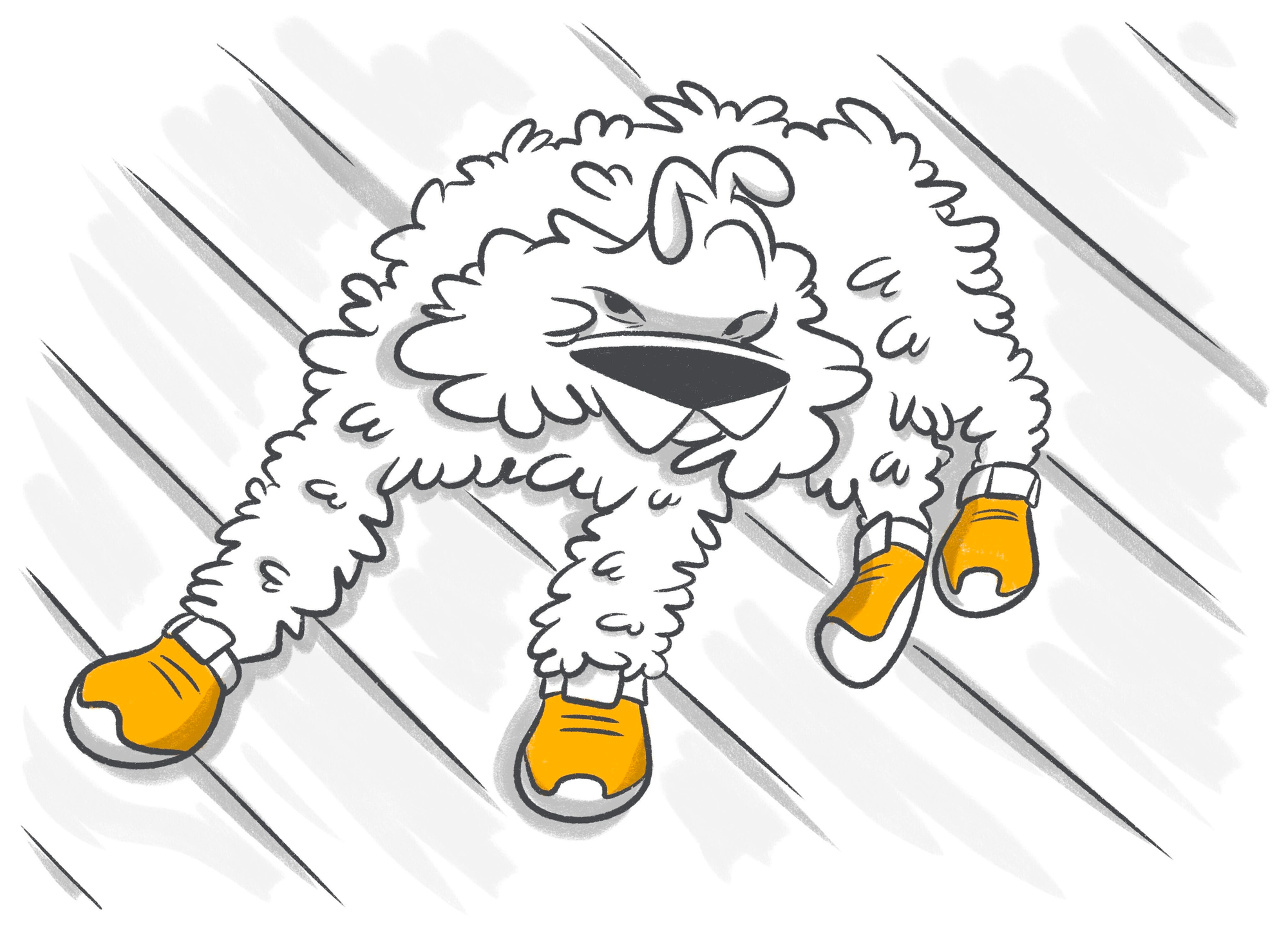If you’ve ever noticed certain dogs having thick and hairy-looking paw pads or noses and wondered what it is, there’s a name for it. It’s a condition called hyperkeratosis. Also known as "hairy dog feet", the name describes the furry-like appearance of the paw pads, which is the area of the skin that is commonly affected. However, the condition may also manifest on a dog’s nose, ears, or elbows.
Dogs of any age or breed may be susceptible to hyperkeratosis, but breeds such as Boston Terriers, Beagles, Boxers, Cocker Spaniels, basset hounds, and Labrador retrievers seem to be more susceptible to the condition.
It may also appear as part of aging in older dogs. Hyperkeratosis may be due to an underlying condition, or there may be no identifiable cause. While hyperkeratosis cannot be cured, uncomplicated cases have a good prognosis for management when treated with topical medications.
Hyperkeratosis can be painful and uncomfortable for your dog, so it’s best to bring them to the vet for a proper diagnosis and treatment plan.
Content:
- Meaning of Hyperkeratosis in Dogs
- What Causes Canine Hyperkeratosis
- Symptoms of Hyperkeratosis in Dogs
- Treatment for Dog Hyperkeratosis
- FAQ
Meaning of Hyperkeratosis in Dogs
To define the condition, hyperkeratosis in dogs is when the skin in areas such as a dog’s paw pads or nose becomes thick and hard due to a surplus of keratinocytes (the skin cells that are responsible for producing keratin), which fails to shed the way it should.
Keratin, being a protein filled with fiber, has an important role in the growth and development of hair, nails, hooves, claws, and the like. Because of this, an imbalance in the keratinocytes' life cycle may pose problems.
Most commonly, the condition manifests in a dog’s paw pads or nose. It may also manifest at pressure points such as the elbows. There are also cases of the condition manifesting in a dog’s ears. Given the condition, the drying out of the areas of the skin where hyperkeratosis manifests may make them more susceptible to infection.
Hyperkeratosis in Dog Paws
The most common type of hyperkeratosis is paw pad hyperkeratosis, hence the name "hairy dog feet". It can usually be found at the outer margins of a dog’s paw pads. The manifestation of dried-out and "furry"-looking paws may make them prone to cracks. And since paws are often exposed to different elements, especially when dogs walk, they may be more susceptible to cracks that may lead to a dog paw infection.
Hyperkeratosis in the Dog Nose
Dog nose hyperkeratosis (also known as nasal hyperkeratosis in dogs) is often manifested in the upper part of the nose and is the second most common type of hyperkeratosis, next to paw pad hyperkeratosis.
Dogs have a heightened sense of smell that is far beyond that of humans. No wonder they love sniffing and touching their noses everywhere. However, if their noses crack as a result of hyperkeratosis, they may be prone to infection.
Hyperkeratosis in Dog Ears
Hyperkeratosis may also manifest as thickened, crusty, and yellowish lesions along the tips of a dog’s ears. This is called ear margin hyperkeratosis and is less common than paw pad hyperkeratosis or nasal hyperkeratosis.
What Causes Canine Hyperkeratosis
If you notice signs of hyperkeratosis in your dog, you might ask questions such as, "Why are my dog's paws so rough?" "Why is my dog’s nose crusty". Let us get to know more about the causes of canine hyperkeratosis below.
In most cases, hyperkeratosis is either genetic (occurring in the first year of a dog’s life) or idiopathic, meaning the cause cannot be determined. In cases of idiopathic hyperkeratosis, it usually manifests in middle-aged or senior dogs.
On the other hand, it may also be caused by underlying conditions such as certain infections, immune-related diseases, and trauma. In detail, below are some of the possible underlying conditions:
Leishmaniasis
This is a parasitic infection often transmitted by sandflies.
Canine Distemper
A highly contagious disease, canine distemper can be transmitted upon contact with infected urine, feces, saliva, or mucus. It is a widespread disease affecting dogs that can be prevented with a vaccine.
Zinc Responsive Dermatosis
This disease of the skin may be acquired when a dog isn’t able to absorb zinc properly.
Pemphigus Foliaceus
A common autoimmune disease of the skin, this condition is usually detected by a biopsy.
Stop Googling - Ask a Real Vet
Trauma
Repeated trauma in an area of the skin, may lead to the overproduction of keratin by the keratinocytes. For instance, if a dog always lies down on hard surfaces, they may develop sores. In areas with pressure on the skin, hyperkeratosis may also manifest.
Symptoms of Hyperkeratosis in Dogs
Hyperkeratosis in dogs is characterized by thick or "furry" skin in areas such as the paw pads, nose, elbows, and ears. Because it results in thick, dry, and rough skin in the said areas, such areas in the skin may crack and erode and may thus be more prone to fungal or bacterial infections.
Thick, rough, and "furry" skin
This is the most noticeable symptom of hyperkeratosis, which often manifests in areas such as the paw pads, nose, elbows, or ears. It usually looks thicker, rougher, drier, and harder than the normal texture of a dog’s skin. Examples include excess skin growth on a dog’s paw and a crusty dog nose, among others.
Cracks and erosions on the skin
Because of the thick and dry skin, the area will be more susceptible to cracks and erosion, making it more susceptible to bacteria and fungi. An example that may indicate the condition is cracked dog paws.
Pain and difficulty walking
In more severe cases, pressure on the affected areas may cause pain, difficulty walking (paw pad hyperkeratosis), and discomfort when lying down (elbow hyperkeratosis).
Bleeding on skin cracks
When thick and dry skin cracks, it has a high chance of bleeding, making it more susceptible to bacterial infections.
To look out for symptoms of hyperkeratosis, a high-quality pet camera such as the Petcube Cam is recommended. With its HD and night vision features, you may be able to detect any symptoms that they may be exhibiting. That way, you may be able to address the condition early on.
Treatment for Dog Hyperkeratosis

How to treat hyperkeratosis in dogs?
For dogs with idiopathic or genetic hyperkeratosis who are otherwise healthy, any infections due to bacteria or yeast should be treated. While hyperkeratosis has no known cure, it can be managed to prevent your dog from feeling pain and discomfort. To treat the condition, balms, and ointments may be recommended to help soften the thick and hard skin and remove the excess tissue.
If the hyperkeratosis is due to a systemic disease, the disease would have to be addressed. Treatment is dependent on the particular condition. For example, if the hyperkeratosis is due to zinc-responsive dermatosis, your dog may need supplements and may have to change diet.
Meanwhile, if the hyperkeratosis is due to the canine distemper virus or leishmaniasis, it’s more complicated to treat. Treatment would depend on the severity of the disease. In many cases, your dog may have to be hospitalized.
For hyperkeratosis due to immune-related conditions, treatment includes medications to suppress your dog’s immune system. They may also be prescribed antibiotics and antifungal treatment if there are secondary infections.
Should you get pet insurance?
We want what’s best for our dogs, and that is why we want them to stay happy and healthy. But what if they get sick — more so if they get into an emergency? Having pet insurance is beneficial for both our pets and ourselves because it helps cover unexpected vet bills.
Petcube’s Pet Emergency Fund offers $3000 a year for all your pets, can be availed of regardless of age, breed, or medical history, and is even better than insurance since there’s no payback. That way, you get the peace of mind that you need while taking care of your pet(s).
FAQ
Can I use Vaseline on my dog?
If your dog is suffering from hyperkeratosis, you may be wondering what you can do to help relieve their pain and discomfort, and Vaseline may come to mind. So can you use Vaseline as a crusty dog nose home remedy? Or can you use it as one of the home remedies for rough dog paws?
Well, technically, Vaseline isn’t toxic for dogs. It helps in the sense that it protects your dog’s skin from dirt, bacteria, and toxins. However, do note that it isn’t 100% safe. Ingesting too much upon licking may cause an upset stomach, leading to diarrhea and vomiting.
How to soften dog paws?
Among the home remedies for rough paws are coconut oil and vitamin E oil. Meanwhile, according to the American Veterinary Medical Association study, you may use wax-based petroleum as well as lanolin products to treat dry skin, but be sure to monitor that they don’t lick it too much. If you are unsure of what to apply to your dog’s paws, it’s best to consult with your veterinarian.
Was this article helpful?
Help us make our articles even better









